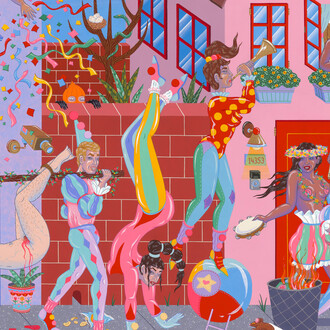Night Gallery is pleased to present American gothic, a two-person exhibition of new work by JPW3 and Grant Levy-Lucero. JPW3’s oil on panel paintings abstract the nameplates of American newspapers into textured, gray expanses and vibrant environmental scenes. Other new works feature bunnies, celestial motifs, and reduced green and black compositions that reference type. Levy-Lucero debuts a series of ceramic sculptures that depict American pop culture icons as cookie jars. Together, the pair defamiliarize the language and symbols that have earned our collective trust.
This is JPW3’s fourth major presentation with the gallery, following Root-bound, 202; Drifting the bog, 2017; and 32 leaves / I don't / the face of smoke, 2014, for which the artist created a sound collaboration with Daniel Pineda. JPW3 also participated in the group show Shrubs, 2022. This is Levy-Lucero’s third major presentation with the gallery, following Reflections, 2021 and Central, 2017-8, and his participation in the group show Majeure force: part two, 2020.
Neville Goddard, the 20th century writer and mystic, said that all our desires are divine, even those we consider profane. Friedrich Nietzsche said, “One loves ultimately one’s desires, not the thing desired.” It’s true: We want desire, because the objects and people who inspire it generate our life force. Desire pulls us out of bed, drives us to work, thrusts us into sex, and gives life meaning. Without it, we are a hunk of unformed clay, a glob of desiccated paint on an unused palette.
But desire has become complicated. It’s not just a primal urge anymore. Consider sweetness. Our bodies want sugar because the treacly flavor tells us that a fruit is safe, filled with carbohydrate energy, and free of toxins, which taste bitter and harsh. So when the pastry chefs and Keebler Elves pack their foods with fructose syrup, they are hijacking our ancient foraging instincts.
The problem is that the Elves are sending us mixed messages. I’m hungover after that bag of cookies, but still, I want more. I’m addicted. I have to hide it in a jar on the top shelf, so I don’t overdo it. This is when the cookie monster is born, a being consumed by its desire. And sweetness, that original ignition of life, becomes our enemy. We can no longer trust our taste.
Of course this is true of all the senses: the tug of color and the allure of form on the eyes is a favorite of art-lovers. Going way back, the most primal version of this feeling is in the stars and flowers. Even now, the sign of an illuminated human is one who steps outside to gaze into the night sky and pauses to behold the elderflower in spring. This is why artists have always depicted such basic optical pleasures. The desire is already there. The artist just has to let it through.
Advertising learned this from art, and the branded icon is the human way of packing strong feelings of desire in a reduced image. The sight of the Disney castle or a Birkin bag floods us with serotonin, not just because we love to look at these things, but because they set off a chain reaction of desires. We identify with the experiences around these symbols. This is how desire transcends the sensorial and becomes intellectual: ideologies are born. Simone Weil said, "The intelligence can only be led by desire”.
We are all subject to this. I desire the certainty of an ideology because I believe my mind will finally relax when it receives the truth, instead of constantly seeking answers. So I turn to my newspaper, believing it will quench this desire. And the first thing I see is that Gothic font: The New York times! The Boston globe! A gleaming symbol of truth. The San Francisco chronicle was my family’s paper. Daily, it bent my rubberneck toward disaster, murder, war, political fracas. Reading it was a ongoing thriller of cliffhanging, fist-pumping righteousness, and with every article, my desire for knowledge was stroked and stoked. I knew what was really going on in the world.
But really, was desire ever simple? Before the rise of media and propaganda, was it ever just about tending your own little plot of land, growing crops, surviving? In a bookstore, looking for truth, I found a book titled American Gothic: A life of America’s most famous painting. The classic painting on the cover depicts an unfortunate-looking couple who have seemingly achieved this pre-industrial dream of sovereignty. But these people look wrecked. Not a glimmer of desire in their eyes. Why does everyone want to look at them? Funny how with such masterworks, celebrity becomes the draw: We can’t even see the painting through all the fame. Crowds of museum-goers line up for hours just to say they saw it. This is a desire to collect the coveted experience.
But real art-desire has always been in its own peculiar category. Because fundamentally, it’s not the desire for fame, or ownership, or even truth. When an artwork hits me right, I am happy to be manipulated by it, because it’s giving me something I can’t get from desserts or ideologies or newspapers — raw sensorial energy. When I find one of these rare works, these glowing sources of desire, I am willing to stand in its presence, absorb its complicated symbols, feel its tugs, and taste its decadent flavors, because these are all the methods it uses to generate its life source. It enters the eyes, mind, heart, and pelvic floor. I’m always looking for a place to feel such things safely, profoundly, and once I’ve found it, I’ll take all the want there is to receive.
(Written by Ross Simonini)
















